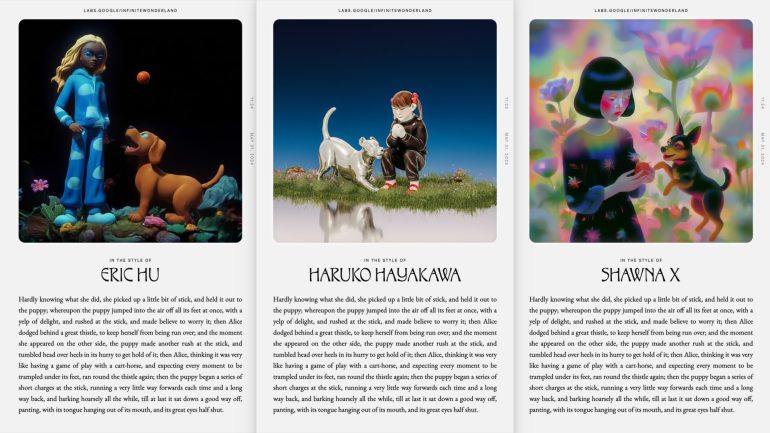- Google I/O conference unveils Infinite Wonderland and StyleDrop, offering a glimpse into the company’s AI strategy.
- Infinite Wonderland reimagines Alice in Wonderland visually with AI-generated illustrations in collaboration with four professional designers.
- StyleDrop empowers users to customize AI-generated illustrations in their preferred artistic styles.
- The project signifies Google’s ambition to engage with creative professionals and reflects evolving perceptions of AI tools in the industry.
- Despite some AI artifacts, the results are sophisticated, resembling authentic artwork.
- AI democratizes content creation but raises concerns about copyright and authenticity.
- Google Creative Lab aims to integrate StyleDrop responsibly into its products, anticipating broader utility beyond initial collaborations.
- The project fosters a shift in mindset within the creative community towards AI adoption, enhancing creative capabilities.
Main AI News:
This year’s Google I/O conference displayed the usual fanfare surrounding the company’s annual product revelations. Yet, nearby, in a more subdued setting, Google offered insights into the trajectory of its AI strategy.
An experimental venture named Infinite Wonderland and a novel tool named StyleDrop took center stage at this event. The concept behind Infinite Wonderland was to re-envision Alice in Wonderland visually with the aid of four adept designers, who trained a Google AI model to create images in their unique artistic styles. This initiative hints at Google’s aspirations to engage with creative professionals and showcases the evolving perception of AI tools within the industry.
Designers Haruko Hayakawa, Eric Hu, Erik Carter, and Shawna X collaborated with Google over several months to master the utilization of Google DeepMind’s Imagen 2 AI generation model, particularly its in-development StyleDrop tool. This tool empowers users to customize the model to generate illustrations in their preferred style by providing their own artwork as reference images. Through an iterative process, they trained StyleDrop with batches of 10 images, demonstrating its adaptability even with minimal reference.
The resulting product, Infinite Wonderland, offers a digital rendition of Lewis Carroll’s Alice’s Adventures in Wonderland. Displayed on a web page, the text from the book appears in the left column, complemented by images on the right. Users can click on any sentence to generate a corresponding image in the style of the four designers or the original illustrator, John Tenniel.
Though some images may bear subtle AI artifacts, the overall outcome is remarkably sophisticated, resembling the authentic work of the contributing artists. However, this duality—challenging yet promising—is emblematic of new AI technologies, echoing Alice’s sentiment: “It’s no use going back to yesterday because I was a different person then.“
In the contemporary professional creative landscape, AI continues to revolutionize workflows amid debates over its implications. While it democratizes content creation for individuals lacking artistic skills, it also poses challenges to established industry norms. Questions surrounding copyright, authenticity, and craftsmanship persist, exemplified by recent legal disputes between artists and Google.
Nonetheless, there’s a shifting mindset within the creative community as practitioners explore AI’s potential. Real-world applications emerge, illustrating the benefits of integrating generative AI assistants like StyleDrop into the creative process. For Hayakawa, initially hesitant about AI, its adoption expanded her creative toolkit, offering new avenues for expression.
Matthew Carey, Google Creative Lab’s group creative director, views such feedback positively, indicating broader utility for AI tools beyond the initial collaboration. As Google Creative Lab endeavors to swiftly integrate StyleDrop into its suite of products, considerations for responsible implementation and intellectual property protection remain paramount.
Infinite Wonderland, characterized as an experimental venture, embodies Google Creative Lab’s ethos of innovation. Through this endeavor, insights gleaned from artists’ interactions with AI technology aim to enhance creative capabilities and empower communities to achieve unprecedented feats of scale.
In Hayakawa’s words, “As an artist, I love the creation process… I really wanted to understand what these tools can mean for me, because technology doesn’t stop for anybody.” Thus, as technology evolves, so too does the creative journey, perpetually unfolding with curiosity and possibility.
Conclusion:
Google’s venture into AI-driven creativity represents a significant evolution in the market, with implications for both professionals and consumers. While offering newfound creative possibilities, it also raises pertinent questions regarding copyright and industry norms. As AI continues to shape the creative landscape, strategic adaptation and responsible utilization will be paramount for market players seeking to leverage its potential.

